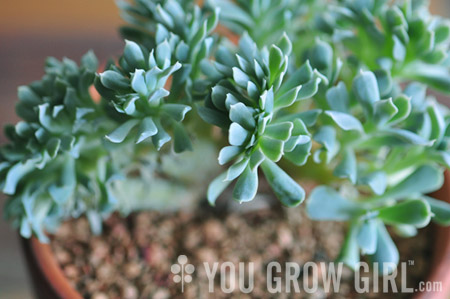
No, it’s not a sea creature out of water. It’s a super freak, super freak, super freaky (Rick James approved) mutated succulent!
Fasciation, cristate, cresting, or bundling: all are words for an interesting genetic mutation that causes a plant to grow gnarled and twisted, thick in some parts and thin in others. Sometimes the plants appear super-pumped, almost as if it were doubling and even tripling back onto itself. These mutations, often occurring at the tips in new growth and sometimes even in the flowers, are triggered by a range of traumas ranging from environmental issues such as chemical exposure and frost, to insect attack, over-crowding, and disease.
And then plant breeders take these random mutations and use them to their advantage to produce far-out, freaky, alien varieties, such as this Echeveria runyonii ‘Topsy Turvy Cristata’.

I absolutely love fasciation, and now that I know what it is I seem to see it everywhere, even in nature!
I first noticed fasciation on a White Coneflower blossom, then I saw it on a branch of Donkey Tail Spurge(Euphorbia). When I looked up more info about the mutation, the common Celosia was given as a prime example. I had Celosia (Cockscomb) in my garden for years not knowing it was a fasciated plant. As a dedicated grower of succulents, I find your photo captivating.
Yes, cockscomb is the best known example. There seem to be a lot of fascinated succulents. In fact, all of the others that I grow are succulents or cacti.
My Regal Lilies do this sometimes. There’s an amazing picture of a fasciated Regal lily at http://www.oldhousegardens.com/regalCate.asp.
Oh wow! I have never seen this in a lily. Love it!
Very cool, like a beautiful piece of abstract art!
Do you know where I can get free or very cheap potting soil?
No. Potting soil is generally one area where you get what you pay for.
It’s beautiful, even if it is super freaky. And a great macro photo shot of the plant too.
What an intriguing color. Respect to the plant breeders who grew this lovely specimen.